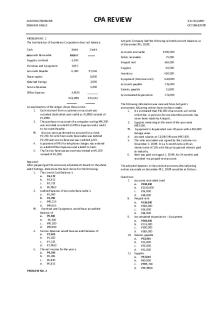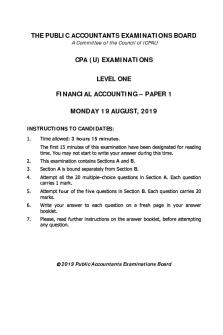CPA08 - CPA 8 - Gillette PDF

| Title | CPA08 - CPA 8 - Gillette |
|---|---|
| Course | Econ & Bus Statistics |
| Institution | University of Kentucky |
| Pages | 2 |
| File Size | 86.3 KB |
| File Type | |
| Total Downloads | 30 |
| Total Views | 158 |
Summary
CPA 8 - Gillette...
Description
ECO391 CPA 8 For Thursday, September 20 Name: In the Jaggia/Kelly text, read Ch. 14, Regression Analysis, Section 14.3, Goodness-of-Fit Measures, pp. 528-533 & Ch. 15, Inference with Regression Models, pp. 544-550 (2 nd edition, pp. 497-501 & 514-520 (1st edition, pp. 441-446, & 456-462. Section 14.4, Goodness-of-Fit Measures 1. What are “goodness of fit” measures designed to summarize? The goodness of fit measures are designed to summarize how well the sample regression equation fits the data. The standard of error of the estimate The coefficient of determination Adjusted coefficient of determination 2. The Standard Error of the Estimate. What does a value of zero for the standard error of the estimate, se, imply? The value of the standard error of the estimate is generally evaluated against the size of what other variable? If the standard error of the estimate s(e) equals 0, then all points fall on the line and there is no dispersion. The value of the standard error of the estimate is generally evaluated against the size of relative magnitude of the residuals.
3. The Coefficient of Determination. What does R2 measure? R^2 measures the sample variability in the response variable y that is explained by changes in the explanatory variable(s), that is, by the sample regression equation.
Important Section! Ch. 15, Inference with Regression Models, Section 15.1 Tests of Significance 4. Using the baseball winning percentage example in the text, what would the null and alternative hypothesis be to test whether a higher team batting average increases winning percentage? What would the null and alternative hypothesis be to test whether a lower earned run average increases winning percentage? Higher BA increases winning % H(0): B(j) < 0 H(a): B(j) > 0
Lower ERA increase winning % H(0): B(j) > 0 H(a): B(j) < 0
5. Write the test statistic for the hypothesis test of an individual regression coefficient β j. Commit this formula to memory.
6. From Example 15.1, how can we conclude at the 5% significance level that winning percentage and batting average have a positive linear relationship? In other words, in question 4 above look at your null and alternative hypothesis for whether a higher batting average increases winning percentage. From Exercise 15.1, what value(s) do we use to reject the null hypothesis at the 5% level and conclude that a higher batting average does increase winning percentage? We can conclude at the 5% significance level that winning percentage and BA have a positive linear relationship because BA’s coefficient is 3.2754 (positive). We can the value of the test statistic t, and then use the associated p-value to compare to .05 significance. Since the associated p-value is approximately 0, we reject the null hypothesis and accept the alternative. At the 5% significance level, there is a linear relationship between winning percentage and BA => batting average is significant in explaining winning percentage....
Similar Free PDFs

CPA08 - CPA 8 - Gillette
- 2 Pages

Gillette - notes
- 11 Pages

Gillette Case Study
- 2 Pages

Group 9 - Gillette indonesia
- 3 Pages

CPA - CH 25 - CPA 25
- 2 Pages

Gillette Case Study
- 15 Pages

CPA Syllabus
- 67 Pages

Cpa 20 2016 fevereiro - CPA 20
- 203 Pages

CAS Gillette - cas gilette analyse
- 14 Pages

E2105 CPA Ch4 F
- 2 Pages

AUDITING PROBLEMS (CPA REVIEW)
- 7 Pages

Document - CPA reviewer
- 11 Pages

Taxation Notes CPA 2
- 340 Pages
Popular Institutions
- Tinajero National High School - Annex
- Politeknik Caltex Riau
- Yokohama City University
- SGT University
- University of Al-Qadisiyah
- Divine Word College of Vigan
- Techniek College Rotterdam
- Universidade de Santiago
- Universiti Teknologi MARA Cawangan Johor Kampus Pasir Gudang
- Poltekkes Kemenkes Yogyakarta
- Baguio City National High School
- Colegio san marcos
- preparatoria uno
- Centro de Bachillerato Tecnológico Industrial y de Servicios No. 107
- Dalian Maritime University
- Quang Trung Secondary School
- Colegio Tecnológico en Informática
- Corporación Regional de Educación Superior
- Grupo CEDVA
- Dar Al Uloom University
- Centro de Estudios Preuniversitarios de la Universidad Nacional de Ingeniería
- 上智大学
- Aakash International School, Nuna Majara
- San Felipe Neri Catholic School
- Kang Chiao International School - New Taipei City
- Misamis Occidental National High School
- Institución Educativa Escuela Normal Juan Ladrilleros
- Kolehiyo ng Pantukan
- Batanes State College
- Instituto Continental
- Sekolah Menengah Kejuruan Kesehatan Kaltara (Tarakan)
- Colegio de La Inmaculada Concepcion - Cebu


